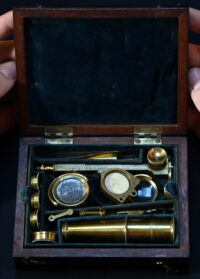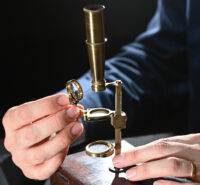 A microscope gifted by naturalist Charles Darwin to his 14-year-old son Leonard is being sold by the family almost 200 years after Darwin acquired it. The microscope, complete with all accessories in its original 3 x 3.5″ mahogany case, is the only Darwin microscope ever offered at auction. Little wonder, as there are only six surviving microscopes known to have belonged to Charles Darwin (including this one).
A microscope gifted by naturalist Charles Darwin to his 14-year-old son Leonard is being sold by the family almost 200 years after Darwin acquired it. The microscope, complete with all accessories in its original 3 x 3.5″ mahogany case, is the only Darwin microscope ever offered at auction. Little wonder, as there are only six surviving microscopes known to have belonged to Charles Darwin (including this one).
It is the oldest one of the six, made by Charles Gould for the firm of instrument-maker William Cary around 1825. The Gould Improved Pocket Microscope was comparatively inexpensive and rapidly became so popular that it was endlessly copied, patents be damned. It was originally designed for observing microorganisms in water which was all the rage in the 1820s. Viewing the “animalcules” in water was literally entertainment and people paid for it. Travelling showmen used portable microscopes like this one to show off all the beasties people were shocked and fascinated to discover they’d been drinking all their lives.
Darwin was into the hobby too, so much so that initially it was actually a detriment to his studies. This very microscope is believed to have been the one he used to blow off med school.
Charles Darwin’s research career began with his investigation into the sea creatures being dredged up from Scotland’s Firth of Forth while trying to avoid his medical studies at the University of Edinburgh. Darwin’s studies of these strange ‘zoophytes’ began in 1826 and reached a successful conclusion in the spring of 1827, when he presented his first scientific paper to the University’s Plinian Society. These dates coincide with the appearance of the present microscope on the market, which was designed by Charles Gould for the firm Cary around 1825. Of the six surviving microscopes associated with Charles Darwin, four are known to have been acquired later (two in 1831, one each in 1847 and around 1848), and the other cannot be used for studying marine invertebrates. In this early research Darwin was contributing to Robert Grant’s radical reinterpretation of the animal kingdom, in which apparently simple creatures – like the ‘zoophytes’ – were understood to be at the beginning of a natural order that led up to Homo sapiens. This preoccupation with the ‘first’ creatures was picked up again by Darwin in the crucial period during and immediately following the Beagle Voyage.
 By the time Charles gave Leonard the scope it was already 30 years old, but he took the same joy in it as his father had when collecting water from the Firth of Forth instead of studying medicine. Four years later, Leonard was a committed microscopist, as Charles recorded in an 1858 letter to his eldest son: “Lenny was dissecting under my microscope and he turned round very gravely & said ‘don’t you think, papa, that I shall be very glad of this all my future life.'”
By the time Charles gave Leonard the scope it was already 30 years old, but he took the same joy in it as his father had when collecting water from the Firth of Forth instead of studying medicine. Four years later, Leonard was a committed microscopist, as Charles recorded in an 1858 letter to his eldest son: “Lenny was dissecting under my microscope and he turned round very gravely & said ‘don’t you think, papa, that I shall be very glad of this all my future life.'”
The presale estimate is £250,000-350,000 ($354,000-483,000), and when the hammer falls at Christie’s on December 15th, that estimate is very likely to be exceeded.